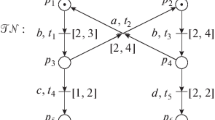Abstract
Dense-Time Petri Nets (TPNs) are a widely-accepted model suitable for qualitative and quantitative modeling and verifying safety-critical, computer-controlled, and real-time systems. Testing equivalences used to compare the behavior (processes) of systems and reduce their structure are defined in terms of tests that processes may or must pass. The intention of the paper is to present a framework for developing, studying and comparing testing equivalences with extended tests (extended future) in interleaving, partial order, and causal tree semantics in the context of safe TPNs (transitions are labeled with time firing intervals, can fire only if their lower time bounds are attained and must fire when their upper time bounds are reached). Additionally, we establish, for the whole class of TPNs and their various subclasses, relationships between testing equivalences and other equivalences from the interleaving—partial order and linear time—branching time spectra. This allows studying in complete detail the timing behavior, in addition to the degrees of relative concurrency and nondeterminism of processes.
Access this chapter
Tax calculation will be finalised at checkout
Purchases are for personal use only
Similar content being viewed by others
Notes
- 1.
The alternative definition of (ii): for all \(1\le i < j\le k\) it holds: \(\bigcup _{1\le l \le i} e_{l}\) is a downward-closed and timely sound subset of \(\bigcup _{1\le m \le j} e_{l}\).
- 2.
A (labeled over Act) time poset (partially ordered set) is a tuple \(\eta =(X,\preceq ,\lambda ,\tau )\) consisting of a finite set X of elements; a reflexive, antisymmetric and transitive relation \(\preceq \); a labeling function \(l:X\rightarrow Act\); and a timing function \(\tau : X \rightarrow \mathbb {T}\) such that \(x\preceq x'\Rightarrow \tau (x)\le \tau (x')\).
- 3.
Notice that in \(\mathcal{C}\mathcal{T}({\mathcal{T}\mathcal{N}})\), for any vertex \(\sigma \in V\), there is a unique path starting from the root and finishing in \(\sigma \).
- 4.
\(\mathcal {F}(\mathcal {L}^*_{po}({\mathcal{T}\mathcal{N}})\), \(\mathcal {L}^*_{po}({\mathcal{T}\mathcal{N}}'))= \{f:TP\rightarrow TP'\mid \) f is a mapping, \([TP]_{\simeq } \in \mathcal {L}^*_{po}({\mathcal{T}\mathcal{N}})\), \([TP']_{\simeq } \in \mathcal {L}^*_{po}({\mathcal{T}\mathcal{N}}') \}\).
References
Andreeva, M., Virbitskaite, I.: Observational equivalences for timed stable event structures. Fundam. Inf. 72(1–3), 1–19 (2006)
Aura, T., Lilius, J.: A causal semantics for time Petri nets. Theor. Comput. Sci. 243(1–2), 409–447 (2000)
Bérard, B., Cassez, F., Haddad, S., Lime, D., Roux, O.H.: Comparison of the expressiveness of timed automata and time Petri nets. In: Pettersson, P., Yi, W. (eds.) Formal Modeling and Analysis of Timed Systems. FORMATS 2005. Lecture Notes in Computer Science, vol. 3829, pp. 211–225. Springer, Berlin (2005). https://doi.org/10.1007/11603009_17
Best, E., Devillers, R., Kiehn, A., Pomello, L.: Concurrent bisimulations in Petri Nets. Acta Inf. 28(3), 231–264 (1991)
Bihler, E., Vogler, W.: Timed Petri nets: efficiency of asynchronous systems. In: Bernardo, M., Corradini, F. (eds.) Formal Methods for the Design of Real-Time Systems. SFM-RT 2004. Lecture Notes in Computer Science, vol. 3185, pp. 25–58. Springer, Berlin (2004). https://doi.org/10.1007/978-3-540-30080-9_2
Boyer, M., Roux, O.H.: On the compared expressiveness of arc, place and transition time Petri nets. Fundam. Inf. 88(3), 225–249 (2008)
Bozhenkova, E., Virbitskaite, I.: Testing equivalences of time Petri nets. Program Comput. Softw. 46(4), 251–260 (2020)
Bushin, D., Virbitskaite, I.: Comparative trace semantics of time Petri nets. Program Comput. Softw. 41(3), 131–139 (2015)
Darondeau, Ph., Degano, P.: Refinement of actions in event structures and causal trees. Theor. Comput. Sci. 118(1), 21–48 (1993)
van Glabbeek, R.J.: The linear time—branching time spectrum I: the semantics of concrete, sequential processes. In: Bergstra, J.A., Ponse, A., Smolka, S.A. (eds.) Handbook of Process Algebra, pp. 3–99. Elsevier (2001)
van Glabbeek, R.J., Goltz, U., Schicke, J.-W.: On causal semantics of Petri nets. In: Katoen, JP., König, B. (eds.) CONCUR 2011—Concurrency Theory. CONCUR 2011. Lecture Notes in Computer Science, vol. 6901, pp. 43–59. Springer, Berlin (2011). https://doi.org/10.1007/978-3-642-23217-6_4
Goltz, U., Wehrheim, H.: Causal testing. In: Penczek, W., Szalas, A. (eds.) Mathematical Foundations of Computer Science. MFCS 1996. Lecture Notes in Computer Science, vol. 1113, pp. 394–406. Springer, Berlin (1996). https://doi.org/10.1007/3-540-61550-4_165
Merlin, P., Faber, D.J.: Recoverability of communication protocols-implications of a theoretical study. IEEE Trans. Commun. 24(9), 1036–1043 (1976)
De Nicola, R.: Behavioral equivalences. In: Padua, D. (ed.) Encyclopedia of Parallel Computing, pp. 120–127. Springer, Boston, MA (2011)
De Nicola, R., Hennessy, M.: Testing equivalence for processes. Theor. Comput. Sci. 34, 83–133 (1984)
Nielsen, M., Rozenberg, G., Thiagarajan, P.S.: Behavioural notions for elementary net systems. Distrib. Comput. 4(1), 45–57 (1990)
Pomello, L., Rozenberg, G., Simone, C.: A Survey of equivalence notions for net based systems. In: Rozenberg, G. (ed.) Advances in Petri Nets. Lecture Notes in Computer Science, vol. 609, pp. 410–472. Springer, Berlin (1992). https://doi.org/10.1007/3-540-55610-9_180
Rabinovich, A., Trakhtenbrot, B.A.: Behavior structures and nets. Fundam. Inf. 11, 357–404 (1988)
Tarasyuk, I.V.: Equivalences for behavioural analysis of concurrent and distributed computing systems. “Geo” Publisher, Novosibirsk (2007) (in Russian)
Vogler, W.: Modular construction and partial order semantics of Petri nets. Lecture Notes in Computer Science, vol. 625. Springer, Berlin (1992)
Virbitskaite, I., Bushin, D., Best, E.: True concurrent equivalences in time Petri net. Fundam. Inf. 149(4), 401–418 (2016)
Author information
Authors and Affiliations
Corresponding author
Editor information
Editors and Affiliations
Rights and permissions
Copyright information
© 2023 The Author(s), under exclusive license to Springer Nature Switzerland AG
About this chapter
Cite this chapter
Bozhenkova, E., Virbitskaite, I. (2023). Extended Future in Testing Semantics for Time Petri Nets. In: Schlingloff, BH., Vogel, T., Skowron, A. (eds) Concurrency, Specification and Programming. Studies in Computational Intelligence, vol 1091. Springer, Cham. https://doi.org/10.1007/978-3-031-26651-5_4
Download citation
DOI: https://doi.org/10.1007/978-3-031-26651-5_4
Published:
Publisher Name: Springer, Cham
Print ISBN: 978-3-031-26650-8
Online ISBN: 978-3-031-26651-5
eBook Packages: Intelligent Technologies and RoboticsIntelligent Technologies and Robotics (R0)




